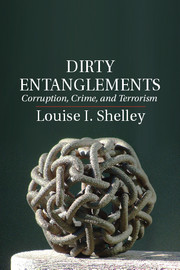Book contents
- Frontmatter
- Dedication
- Contents
- Figure, Maps, and Tables
- Acknowledgments
- Introduction
- Part I The Logic of Corruption, Crime, and Terrorism
- Part II The Diverse Businesses of Terrorism
- 5 The Business of Terrorism and Criminal Financing of Terrorism
- 6 The Drug Trade
- 7 The Less Policed Illicit Trade
- 8 Ultimate Fears
- Conclusion
- Index
- References
8 - Ultimate Fears
Weapons of Mass Destruction and Crime-Terror Connections
Published online by Cambridge University Press: 05 August 2014
- Frontmatter
- Dedication
- Contents
- Figure, Maps, and Tables
- Acknowledgments
- Introduction
- Part I The Logic of Corruption, Crime, and Terrorism
- Part II The Diverse Businesses of Terrorism
- 5 The Business of Terrorism and Criminal Financing of Terrorism
- 6 The Drug Trade
- 7 The Less Policed Illicit Trade
- 8 Ultimate Fears
- Conclusion
- Index
- References
Summary
In the 1990s, the Japanese cult Aum Shinrikyu sought nuclear, biological, and chemical weapons, representing a convergent threat that may be replicated in the future. Analyses of this well-known case reveal that the chemical weapons of mass destruction (WMD) program of this sect was ultimately much more successful than its biological efforts. The cult’s failure is explained by their inability to recruit Russian scientists in the difficult final years of the Soviet state, making them dependent on Japanese engineers and scientists, who lacked experience in WMD deployment. Having to train its own personnel, Aum’s weapons preparation proceeded slowly.
The first cult laboratory for toxin production was actually in place by 1990 and was subsequently replaced with two new laboratories, one at Kamakuishki and the other in Tokyo. Aum dabbled in many different biological agents. They cultured and experimented with botulin toxin, anthrax, cholera, and Q fever. In 1993, Ashahara led a group of 16 cult doctors and nurses to Zaire, on a supposed medical mission. The actual purpose of the trip to Central Africa was to learn as much as possible about, and, ideally, to bring back samples of, Ebola virus. In early 1994, cult doctors were quoted on Russian radio as discussing the possibility of using Ebola as a biological weapon.
An attempted release by Aum of anthrax from its midrise Tokyo office building and laboratory in June 1993 was unsuccessful, as the group unknowingly used a nonlethal vaccine strain of anthrax.
- Type
- Chapter
- Information
- Dirty EntanglementsCorruption, Crime, and Terrorism, pp. 289 - 319Publisher: Cambridge University PressPrint publication year: 2014

